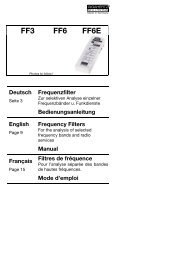HF-Analyser - Gigahertz Solutions
HF-Analyser - Gigahertz Solutions
HF-Analyser - Gigahertz Solutions
Create successful ePaper yourself
Turn your PDF publications into a flip-book with our unique Google optimized e-Paper software.
Made in Germany<br />
range 6 . The basic rule is: as coarse as necessary, as fine as<br />
possible. In the rare case of power densities beyond the designed<br />
range of the analyser (“1“ displayed on the left hand side<br />
even in the coarsest range) they can still be measured by inserting<br />
the attenuator DG20, available as an optional accessory, which<br />
makes the instrument less sensitive (by a factor of 100).<br />
Setting Signal Evaluation (“Signal“): The peak <strong>HF</strong> radiation<br />
value, not the average value, is regarded as the measurement of<br />
critical “biological effects“ affecting the organism and to be compared<br />
to recommended safety limits.<br />
The average value (“RMS“) of pulsed signals is often only a very<br />
small fraction of the peak value. Nontheless it forms the basis of<br />
most of the ”official“ safety limits regulations. Building biologists<br />
consider this a trivialization.<br />
„Peak hold“ (<strong>HF</strong>38B only) simplifies measurements of the total<br />
exposure by retaining the highest readings for some time (it slowly<br />
drops). Note of caution: Switch on ”softly“ to avoid switching<br />
peaks, which then will be retained for some time simulating unrealistic<br />
power densities. If peaks are very short and very high the<br />
holding capacity needs an instant until it is fully charged.<br />
How to execute the measurements<br />
Hold the <strong>HF</strong> analyzer with a slightly outstretched arm, your hand<br />
at the rear of the instrument.<br />
For a rough first overview it is sufficient to probe for areas of<br />
higher levels of radiation simply by following the audio signals<br />
walking through the rooms of interest, directing the analyser everywhere<br />
and rotating it.<br />
Having identified the area of interest for a closer evaluation,<br />
change the positioning of the instrument in order to analyse the<br />
actual power flux density. This is done<br />
by pointing in all directions including upwards and downwards<br />
in flats to establish the main direction of the incoming radiation,<br />
by rotating the instrument around its longitudinal axis by up to<br />
90 ° to also find the plane of polarisation, and<br />
by shifting the instrument in order to find the point of maximum<br />
exposure and to avoid being trapped by local cancellation effects.<br />
It is generally accepted to use the highest reading in the room<br />
for comparison with limit or recommended values.<br />
6 <strong>HF</strong>38B – „Range“: When switching from ‘Coarse’ to ‚Medium’ for very small<br />
readings, it could happen, that the instrument tolerance of +/- 3 dB full range is<br />
absorbed. In this worst case there may be a factor 4 between the displayed<br />
numbers in ‚Coarse’ and ‚Medium’. Example: In ‘Medium’ you read 150.0<br />
µW/m². If worst comes to worst ‘Coarse’ might show between 0.6 und 0.03<br />
mW/m² (instead of 0.15 mW/m² which would be the correct value). However,<br />
normally the differences shown will be much smaller. For comparing measurements<br />
(e.g. ‘before’ and ‘after’) take the same range setting.<br />
10 © <strong>Gigahertz</strong> <strong>Solutions</strong> GmbH



